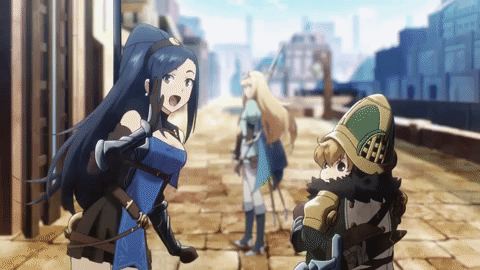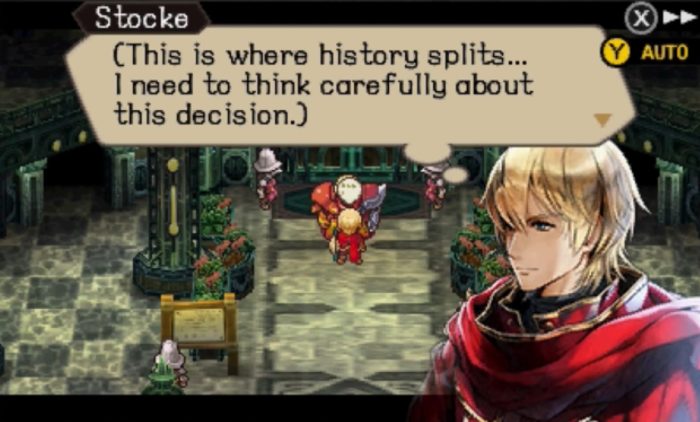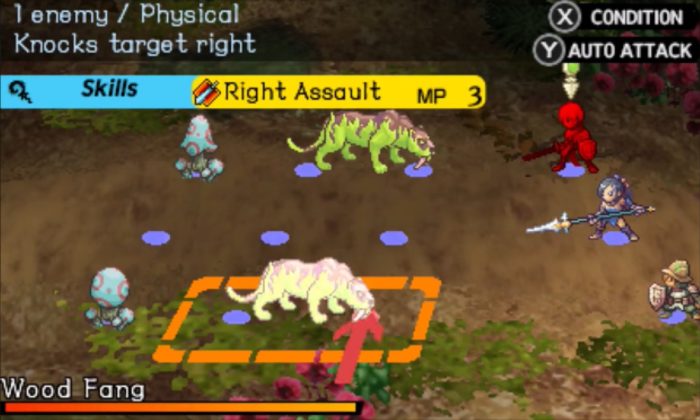Radiant Historia: Perfect Chronology on 3DS
Playing Radiant Historia: Perfect Chronology felt like I was being swept through time – back to the golden era of traditional JRPGs when turn-based combat and strategic decision-making outweighed quick time events and stylish action scenes. From the 2D graphics down to its grid-based battles, it’s pretty clear that the 3DS remake tries to make the most of its original charms. However, Radiant Historia: Perfect Chronology has also changed with the times, offering a refreshing take on the underrated game.
For a quick recap, Radiant Historia was originally released on the Nintendo DS back in 2010 before its localization in 2011. The story follows a young man named Stocke who is caught up in the political affairs between two warring kingdoms on the continent of Vainqueur: Alistel and Granorg. During one mission, he receives a mysterious book, the White Chronicle, which gives him the power to travel through time and change history. Stocke soon learns about the harsh truth behind his continent and how the mysterious plague, desertification, is destined to destroy the world. Using his newfound abilities, he sets off on a quest to uncover the “true” timeline where the world is saved from both plague and war.
While most of the game is seen through Stocke’s eyes, Radiant Historia: Perfect Chronology also features a handful of other delightful characters. Vainqueur is a diverse continent filled with different races and cultures. Despite the war-torn battlefields and fear of desertification, the world still feels brimming filled with life. Our main character is supported by a handful of other playable characters – such as his best friend, Rosche, and the Princess of Granorg, Eruca. I also have to give props to the amazing supporting cast who all actually felt like real characters instead of just plot devices.

Each person had their own personal motivations and ideals that helped steer the narrative, and I was absolutely enamored. Everyone felt distinctive, each fighting for a cause they personally believed in. Splendid writing aside, the newly added voice acting also helped flesh out the characters in the game. There are plenty of factors behind any war, and the same can be said for the battles in Vainqueur. That said, Radiant Historia: Perfect Chronology manages to show each side of the conflict through those who are affected the most: its people, through the use of the White Chronicle.
Apart from time traveling, this mysterious book also allows Stocke to shift between two pivotal histories early on in the story. The Standard and Alternate histories are two pieces of the same puzzle, and players must explore both sides to see the bigger picture. The game doesn’t allow time hopping at a whim, however, as you can only access the White Chronicle at save points. You can view the game’s entire timeline from there and travel to a certain point in time by selecting a Node.
These Nodes are special events in history that usually appear during important moments in the game, such as when Stocke must make an important decision. The choices will either keep the plot moving or end it, but even if you choose the wrong option, Stocke will always return to Historia, where you can pick up right where you left off. There are no penalties for picking the “bad endings” scattered throughout the histories, and you’ll even have to see all of them if you want to complete the timeline.

The Standard and Alternate histories each have their own accounts, but most of the main characters appear on both sides. This narrative style was a great way to add some depth to Radiant Historia: Perfect Chronology, providing different angles to the war. And while you might feel a little more attached to a certain history, you can’t just leave the other one untouched. There are different gate mechanics in almost every chapter in both histories, and the solutions are usually found in the other history. Traveling through Node after Node should feel exhausting, but the Start button lets you skip any cutscenes you’ve already seen, letting you cut straight to your objective. You’ll also keep your party’s current levels, so you won’t have to worry about grinding.
Radiant Historia: Perfect Chronology further expands its story with the use of its new character: Nemesia. This mysterious historian is also looking for her own way to stop desertification and asks Stocke for some much-needed help, sending him on optional missions. These quests still take place within Vainqueur, albeit different versions of the world. These quests mainly focus on the narrative, expanding on the “what if” possibilities within the game’s universe. Thankfully, Radiant Historia: Perfect Chronology adjusts to new players by offering two modes: the Perfect mode for returning fans, and the Append mode for those new to the series. The latter adds the new content after you’ve finished the main story, so you won’t confuse any of the new scenes with the pre-existing ones.
Apart from its timeline, Radiant Historia: Perfect Chronology also offers a large map of Vainqueur. There is no open world, but instead, you just choose the location where you want to travel to. These locations are fully explorable, though, as Stocke must clear them to unlock new points on the map. Exploration is fairly simple and straightforward, but Stocke will earn special field skills throughout the story that can unlock new paths. Several areas have some closed off parts that you can revisit later on once you unlock more skills, and I found some pretty useful gear and items by taking the time to travel back to these paths.
You’ll also encounter some enemies roaming around the field. Touching them will automatically trigger a battle, but you can strike them with your sword for a slight advantage. Fights in Radiant Historia: Perfect Chronology shake up the typical turn-based battles by placing enemies in a 3×3 grid field. There’s a strong sense of strategy during fights as it relies heavily on stringing combos together through succeeding attacks. Using various skills, characters can push and position the opponents around the field and even stack them together. Characters have their own unique abilities, and I had plenty of fun reorganizing my team to craft new battle plans.

Ideally, it’s always best if your three fighters attack consecutively, but that isn’t always the case in Radiant Historia: Perfect Chronology. Luckily, characters can swap their turns with allies and enemies alike, allowing you to plan your strategies. Effective combos start off as a great way to quickly take out enemies but soon become a necessary means of survival later on in the game. The game also rewards players who stack their combos strings, giving characters more EXP and money after the fight.
Meanwhile, those who aren’t in your active party will also assist you through their support attacks, sneaking in a quick hit or buff from time to time. There were times when I didn’t need their help, though, as one support character would target an enemy I was already going to finish off, pretty much rendering one of my turns useless. Nonetheless, Support attacks worked really well during major boss fights and it felt like everyone was actually contributing to the fight.
If you enjoy the combat and want to test your mettle, you can try your luck at the newly added Vault of Time in Radiant Historia: Perfect Chronology. This area is accessed within the White Chronicle and is teeming with different types of monsters. You’ll have to rely solely on skills though since you can’t use any items whatsoever. Fights won’t give you money, but another type of currency called Mementos you can only use in the shop within the Vault of Time. Items and weapons aside, the shop also sells some exclusive skills, so it’s worth taking a bit of your time to stop by the Vault. Just remember that you can’t keep any Mementos you collect when you leave, so don’t be afraid to spend all of it.
In terms of graphics, Radiant Historia: Perfect Chronology hasn’t changed much from the original game. The 2D sprites seem a bit crisper, but it retains the DS version’s overall style and presentation. That said, the game’s visuals don’t exactly stand out when compared to other 3DS role-playing games, so it might look a bit dated to some players. The real visual upgrade was in the character portraits. These new images look much more vibrant with its use of brighter colors, and I personally prefer them over the original artwork.
Looking back, I really enjoyed my 40-hour experience with Radiant Historia: Perfect Chronology. From the fluid storyline down to its tactical combat, I was absolutely hooked. And when the credits finally rolled, I still couldn’t bring myself to leave the cast I’ve grown to love. Radiant Historia: Perfect Chronology is an expanded remake done right, and it’s a solid recommendation for anyone looking for a solid JRPG experience.
Score: 4/5 – Great
Pros
| Cons
|

